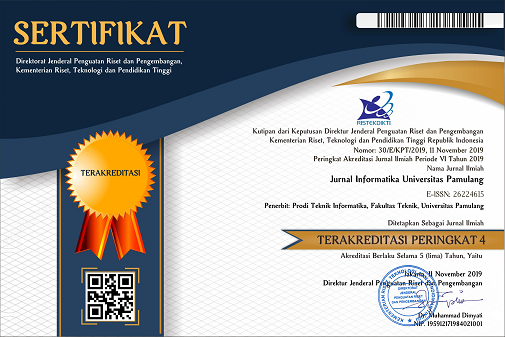Eksplorasi Teknologi Pendukung Data Science untuk Industri Unggulan di Wilayah Kota Surabaya dan Sekitarnya
DOI:
https://doi.org/10.32493/informatika.v6i2.10056Keywords:
data science, pattern recognition, clustering, prediction, decision makingAbstract
Data science competence is still quite uncommon for most people, even though this competence is very important in managing business development strategies in various leading industrial fields. Through data science, companies can find patterns, perform clustering, calculate predictions more accurately to make decisions that have an impact on company excellence. Lack of knowledge about data science, researchers seek firstly in the industry to explore tools that are mostly used, convenience, challenges, measuring success tools and advantages. In this study, the researchers conducted a Focus Group Discussion by interviewing resource persons who worked as Data Scientists. Interview method to discuss aspects of Demographics, aspects of Technology-Task Fitness, and aspects of the Technology Acceptance Model. The results of this study conclude that the tools that are the mainstay of the industry in Surabaya and its surroundings area are Jupyter Notebook, Python, and Tableau. The success in using these tools still depends on the user's abilities, the results of user simulations, team discussions, and the evaluation process.
References
Ahmed, T., Chandran, V.G.R., Klobas, J.E., Liñán, F. and Kokkalis, P. (2020) ‘Entrepreneurship education programmes: how learning, inspiration and resources affect intentions for new venture creation in a developing economy’, The International Journal of Management Education, Vol. 18, No. 1, p.100327.
Berman, F., Rutenbar, R., Hailpern, B., Christensen, H., Davidson, S., Estrin, D., Franklin, M., Martonosi, M., Raghavan, P., Stodden, V., & Szalay, A. S. (2018, April). Realizing the Potential of Data Science. Communications of the ACM, 61(04), 67–72. https://doi.org/10.1145/3188721
Bischoff, K., Volkmann, C. K., & Audretsch, D. B. (2018). Stakeholder collaboration in entrepreneurship education: An analysis of the entrepreneurial ecosystems of European higher educational institutions. The Journal of Technology Transfer, 43(1), 20–46.
Liñán, F., RodrÃguez-Cohard, J. C., & Rueda-Cantuche, J. M. (2011). Factors affecting entrepreneurial intention levels: A role for education. The International Entrepreneurship and Management Journal, 7(2), 195–218.
Medeiros, M. M. de, Hoppen, N., & Maçada, A. C. G. (2020). Data science for business: benefits, challenges and opportunities. Bottom Line, 33(2), 149–163. https://doi.org/10.1108/BL-12-2019-0132
Nabi, G., Walmsley, A., Liñán, F., Akhtar, I., & Neame, C. (2018). Does entrepreneurship education in the first year of higher education develop entrepreneurial intentions? The role of learning and inspiration. Studies in Higher Education, 43(3), 452–467.
O. Nyumba, T., Wilson, K., Derrick, C. J., & Mukherjee, N. (2018). The use of focus group discussion methodology: Insights from two decades of application in conservation. Methods in Ecology and evolution, 9(1), 20-32.
Rogala, P., Batko, R., & Wawak, S. (2017). Factors affecting success of training companies. Studies in Continuing Education, 39(3), 357–370. https://doi.org/10.1080/0158037X.2017.1336995
Tanamal, R. (2019). What Is the Most Influential Factor On Decisions Using Youtube As A Tool To Support Buy Or Sell Means? Case Study Surabaya City And Surrounding Area. Journal of Theoretical and Applied Information Technology, 97(20), 2406-2418.
Wiradinata, T., & Antonio, T. (2018). Developing Technology Entrepreneurship Subjects: A Four-Year Evaluation. International Journal of Innovation, Management and Technology, 9(1), 37–41. https://doi.org/10.18178/ijimt.2018.9.1.784.
Wu, Y. C. J., Kuo, T., & Shen, J. P. (2013). Exploring social entrepreneurship education from a web-based pedagogical perspective. Computers in Human Behavior, 29(2), 329–334
Downloads
Published
Issue
Section
License
Authors who publish with this journal agree to the following terms:
- Authors retain copyright and grant the journal right of first publication with the work simultaneously licensed under a Creative Commons Attribution-NonCommercial 4.0 International (CC BY-NC 4.0) that allows others to share the work with an acknowledgement of the work's authorship and initial publication in this journal.
- Authors are able to enter into separate, additional contractual arrangements for the non-exclusive distribution of the journal's published version of the work (e.g., post it to an institutional repository or publish it in a book), with an acknowledgement of its initial publication in this journal.
- Authors are permitted and encouraged to post their work online (e.g., in institutional repositories or on their website) prior to and during the submission process, as it can lead to productive exchanges, as well as earlier and greater citation of published work (See The Effect of Open Access).
Jurnal Informatika Universitas Pamulang have CC-BY-NC or an equivalent license as the optimal license for the publication, distribution, use, and reuse of scholarly work.
In developing strategy and setting priorities, Jurnal Informatika Universitas Pamulang recognize that free access is better than priced access, libre access is better than free access, and libre under CC-BY-NC or the equivalent is better than libre under more restrictive open licenses. We should achieve what we can when we can. We should not delay achieving free in order to achieve libre, and we should not stop with free when we can achieve libre.
Jurnal Informatika Universitas Pamulang is licensed under a Creative Commons Attribution-NonCommercial 4.0 International (CC BY-NC 4.0)
YOU ARE FREE TO:
- Share : copy and redistribute the material in any medium or format
- Adapt : remix, transform, and build upon the material for any purpose, even commercially.
- The licensor cannot revoke these freedoms as long as you follow the license terms





